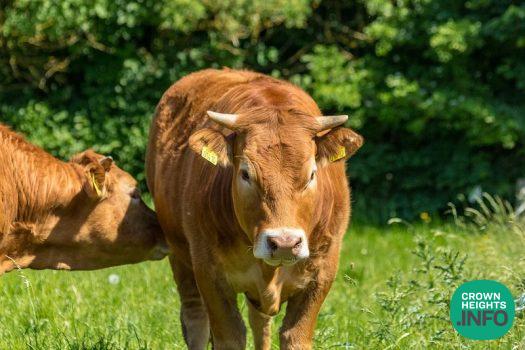
Weekly Dvar Torah: Feast of the Future – Shor Habor and Livyasan
This week’s Torah portion outlines the signs of Kosher animals—those permitted for consumption and those that are not. At first glance, it seems like a list of dietary laws. But Chassidus reveals something far deeper: these aren’t just food regulations; they are a divine map of spiritual elevation. The Kosher laws teach us how to refine the world and ourselves, one bite at a time.
In the language of Kabbala, everything we consume has a spiritual root. Eating is not just a physical act—it’s a sacred opportunity to elevate the inanimate, vegetative, and animal realms into something higher through our service of Hashem. Each Kosher food item represents a potential for transformation. But the pinnacle of this elevation—the moment when all of this spiritual effort reaches its climax—is symbolized in one of the most fantastical images in our tradition: the feast of Moshiach, featuring two mythical creatures—the Shor Habor (Wild Ox) and the Livyasan (Leviathan).
The Midrash and Talmud tell us that in the days to come, the Livyasan will slaughter the Shor Habor with its fins, and the Shor Habor will gore the Livyasan with its horns. Then, the Tzaddikim will sit down to a feast of their flesh. This is not just cosmic cuisine—it’s a metaphor for the synthesis of the deepest forces within creation.
The Shor Habor, dwelling on land, represents the revealed Tzaddik—the righteous individual whose holiness is visible, whose service of G-d is expressed in tangible, practical ways. The Livyasan, hidden in the sea’s depths, represents the concealed Tzaddik—the mystic, the inward soul, whose divine light is hidden from view, but whose spiritual depth is immeasurable.
These two archetypes are not only found among Tzaddikim—they exist within each of us. We all contain a part of us that is open, expressive, engaging the world in Mitzvos and action. And we all harbor a part of us that is hidden, submerged in inner faith, transcendent yearning, and quiet devotion. The final feast symbolizes the unification of these two inner worlds—the revelation of the hidden, and the elevation of the revealed. In the end, each “slays” the other. The Livyasan cuts through the brute force of the ox with fluid grace; the ox pierces the fish’s concealment with firm resolve. The dance between them reveals that only together can they fulfill their purpose.
This interplay is also reflected in the laws of Kosher creatures. Land animals, to be Kosher, must chew their cud and have split hooves—symbols of internal refinement and external separation from impurity. Their Kosher status requires shechita, blood removal, inspection—because they live openly in the physical world, which requires active refinement.
Fish, by contrast, need no slaughter. As long as they have fins and scales, they are Kosher upon removal from the water. This is because they live in a concealed, spiritual realm—water being symbolic of G-dliness in Kabbalah. The fish is the soul that swims in Torah, that cannot survive outside the ocean of holiness. This is the Tzaddik of concealment, whose holiness is so innate, it requires no external refinement.
And yet, in the end, both the fish and the ox are consumed—elevated—together. The Tzaddik of simplicity and action, and the Tzaddik of depth and mystery are both part of the feast. Why? Because G-d doesn’t only desire transcendence. He wants a dwelling in the lower realms. He wants the fish and the ox—the mystical yearning and the sweaty work of Mitzvos—to rise together in harmony.
The Kosher laws help guide us toward this integration. The Torah categorizes not just what is holy, but what can be elevated. Predators and scavengers—creatures that harm or feed on decay—are not Kosher. Why? Because holiness is not destruction. Elevation comes from kindness, from nurturing, from growth. A Kosher animal gives: wool, milk, labor. It represents a being aligned with the process of elevation, not self-indulgence.
So too, our souls are meant not to dominate but to transform. To take the physical and sanctify it. That’s why the Korbanos (sacrifices) in the Beit Hamikdash came from Kosher animals. Even the animal yearns to be elevated—to be part of something greater than itself.
Today, our kitchen tables are our altars. Our meals, infused with Kavana (intention), become offerings. When we eat Kosher food, prepared and consumed in holiness, we are participating in the great cosmic process of drawing down G-dliness into the physical world. Even gefilte fish and cholent become spiritual tools.
And this brings us back to the Messianic feast. That meal isn’t about exotic creatures—it’s about what they represent. The unification of two worlds. The culmination of all the meals we’ve ever eaten with intention, all the Mitzvos we’ve done with our hands and hearts. It’s about the moment when our hidden faith and revealed actions finally merge, and G-d’s essence shines openly in this world.
As we enter the month of Iyar—Ani Hashem Rofecha, “I am G-d your Healer”—we carry the energy of redemption from Pesach into the weeks of counting the Omer. Each day is a refinement, a small meal in the feast of transformation. We know Moshiach is near, not just because we hope, but because we are already preparing the table.
So let’s eat with purpose. Let’s live with awareness. Let’s be the Shor Habor in the field and the Livyasan in the deep—and know that soon, very soon, we will all sit together at the table where the physical and the spiritual will finally taste as one.
In the meantime, pass the Chrein please.
Have a Feast of a Tasty Shabbos,
Gut Shabbos
Rabbi Yosef Katzman











